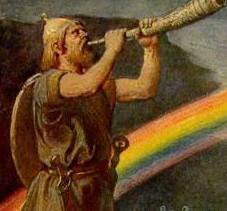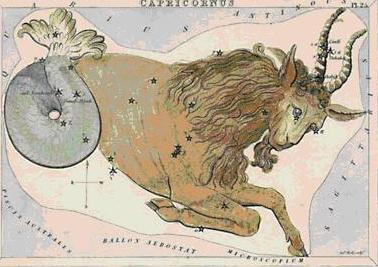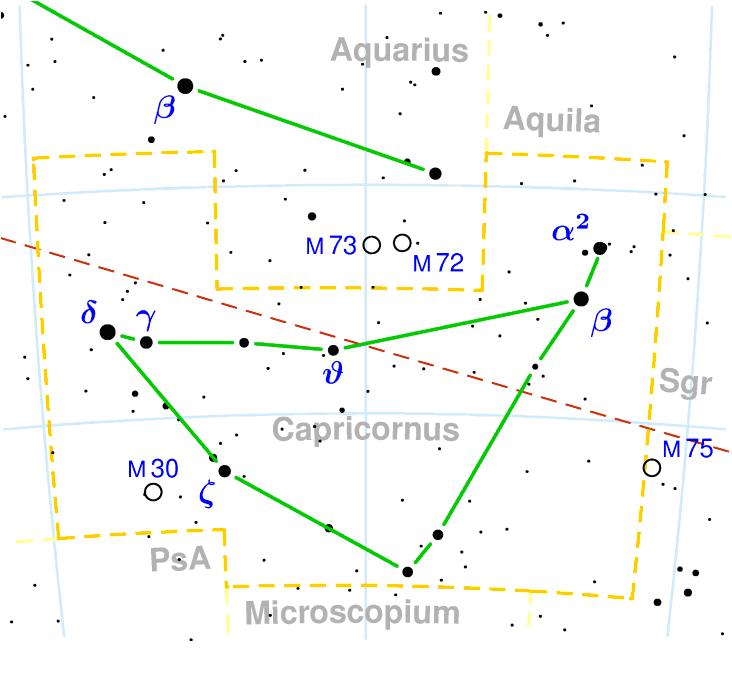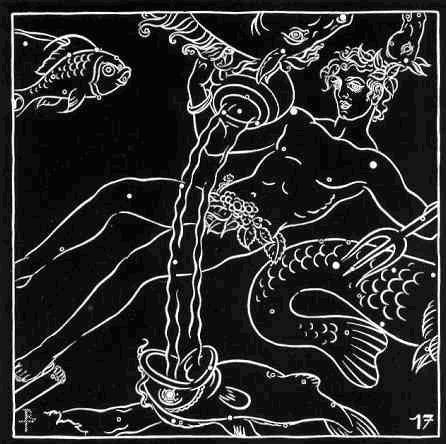Heimdallr – The God with the Wet Back
by Peter Krüger
©2011
Return to Germanic Astronomy

Heimdall painting by Emil Doepler
The god Heimdallr is still very obscure.
There is no conclusive translation of his name and many aspects
in the descriptions of him in poetry remain unclear. Using an
astronomical approach to learn more about his character we will
focus first on his main attributes and screen the constellations of the
Romans and Greeks for parallels. This approach has already lead to an
identification of Völund with the constellation Hercules, the kneeling
man, his nemesis Nidud and Völund's sword with Böotes and Arcturus
respectively, and Virgo
with Spica, the golden ring given to Nidud's daughter Bödvild.
The most famous attribute of Heimdallr is surely
his horn, called the Gjallarhorn. This horn is attested several times
in the Eddas. The only mention of Gjallarhorn by that name occurs in the
Eddic poem Völuspá, wherein a völva foresees the events of
Ragnarök and the role which Heimdallr and his Gjallarhorn will play at
its onset; Heimdallr will raise his horn and blow loudly. Due to its
relative obscurity, translations of this stanza vary:
46.
Leika
Míms synir,
en mjötuðr kyndisk
at inu galla
Gjallarhorni.
Hátt blæss Heimdallr,
horn er á lopti,
mælir Óðinn
við Míms höfuð.
"Fast move the sons of Mim and fate
Is heard in the note of the Gjallarhorn;
Loud blows Heimdall, the horn is aloft,
In fear quake all who on Hel-roads are."
(Henry Adam Bellows translation)
"Mim's sons dance,
but the central tree takes fire,
at the resounding Giallar-horn.
Loud blows Heimdall,
his horn is raised;
Odin speaks with Mim's head."
(Benjamin Thorpe translation)
Heimdall's horn is also mentioned earlier in
Voluspa:
She knows that Heimdall's horn is hidden
under the heaven-bright holy tree.
A river she sees flow, with foamy fall,
from Valfather's pledge.
Understand ye yet, or what?
(Benjamin Thorpe translation)
"I know of the horn of Heimdall, hidden
Under the high-reaching holy tree;
On it there pours from Valfather's pledge
A mighty stream: would you know yet more?"
(Henry Adam Bellows translation)
However, not in all translations it is translated
as a horn:
She knows that Heimdall's hearing
is hidden under the radiant, sacred tree;
she sees, pouring down, the muddy torrent
from the wager of Father of the Slain;
Do you understand yet, or what more?
(Carolyne Larington translation)
If we now search the Roman and Greek constallations for a horn we find a constellation that includes the word 'horn' in its name. This is Capricornus, usually translated as the “horned male goat” or “goat-horn”. In Anglo-Saxon, the constellation was called buccan horn or bucca, 'the buck’s horn'; in German, Steinbock. Despite its faintness, Capricornus has one of the oldest mythological associations and has been represented since ancient times as a hybrid of a goat and a fish, the Goat-fish.


On one hand, an identification of the Gjallarhorn with Capricornus would make sense, because among other points, Snorri closely associates Heimdall's epithets Heimdali, Hruthr, and Vedr with a ram. Snorri also tells us that the kennings Heimdall’s head and 'Heimdall’s sword' have the same meaning, while Rydberg suggests that this could refer to the ram's weapons, figuratively his 'sword', which are located on his head. On the other side, this conclusion may seem surprising, and thus requires a closer examination.
In Völuspá 27, Heimdall's horn is said to be hidden under the high-reaching holy tree. This tree, with good reason, has often been identified as the Milky Way. Capricornus is a constellation located near the Milky Way. What is interesting is that Capricornus is part of the so-called 'watery region' of the night sky represented by Pisces the Fishes, Aquarius the Water-bearer, Delphinus the Dolphin, Capricorn the Sea-goat, and others. This observation might explain a similarly obscure comment made by Loki in Lokasenna:
48. "Þegi þú, Heimdallr,
þér var í árdaga
it ljóta líf of lagit;
örgu baki þú munt
æ vera ok vaka
vörðr goða."
"Be silent, Heimdallr!
For thee in early days
was
that hateful life decreed:
with a wet back
thou must ever be,
and keep watch
as
guardian of the gods."
(Benjamin Thorpe's translation)
Himingbjorg is the eight, and Heimdall there
O'er men hold sway, it is said;
In his well-built house does the warder of heaven
The good mead gladly drink.
"One there was born
in the bygone days,
Of the race of the gods,
and great was his might;
Nine giant women,
at the world's edge,
Once bore the man
so mighty in arms.
"Gjalp there
bore him,
Greip there bore him,
Eistla bore him,
and Eyrgjafa,
Ulfrun bore him,
and Angeyja,
Imth and Atla,
and Jarnsaxa."
There is another interesting fact; in Völuspá 45, cited below, Heimdallr is also brought into connection with all who are on the Hel-road:
"Fast move the sons of Mim and fate
Is heard in the note of the Gjallarhorn;
Loud blows Heimdall, the horn is aloft,
In fear quake all who on Hel-roads are."
(Henry Adam Bellows translation)
So, having considered these aspects, the identification of Heimdallr with Capricorn the Sea-goat should not seem as surprising or as unrealistic as it may have on first view.
If we can identify Heimdallr as the Sea-goat, a constellation of the zodiac known from Greek myths, then we should also be able to find an equivalent in the Norse myths for the neighboring constellation Aquarius the water-bearer, offering further proof of this identification.
